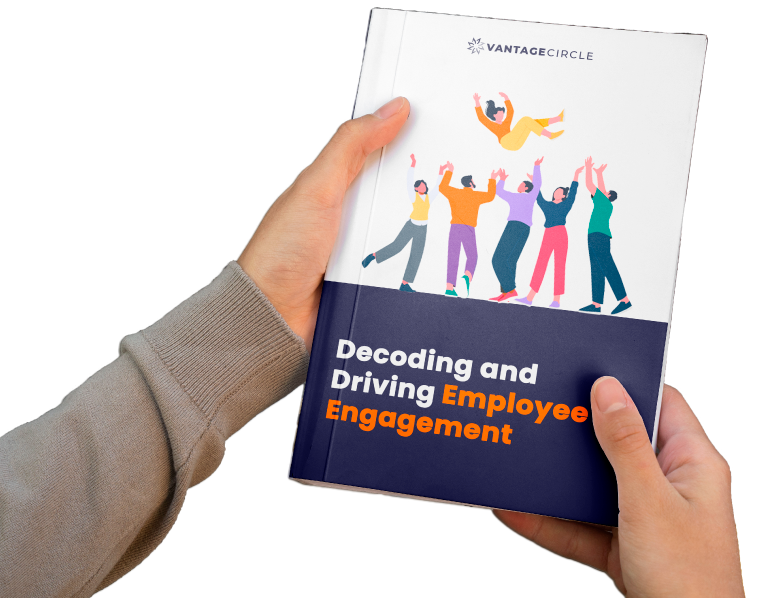Impact of Hybrid Working on Employee Engagement
The way we work has changed forever. The shift to hybrid work wasn’t just a trend born out of necessity during the pandemic but a workplace revolution that transformed how employees thrived.
Remote work was already gaining momentum before COVID, but the pandemic accelerated the process and forced organizations to rethink traditional office setups overnight. The result? A working model that employees have not only adjusted to but, in many cases, strongly prefer.
In fact, six in 10 U.S. employees with remote-capable jobs want a hybrid work arrangement (Gallup).
But here’s the catch—keeping employees engaged in a hybrid model isn’t as simple as it seems. How do you ensure collaboration, productivity, and a strong company culture when your team is split between office desks and home workspaces?
In this blog, we’ll uncover the real impact of hybrid working on employee engagement, its challenges, and the strategies leaders can use to keep their teams motivated and connected.
So, let’s dive in!
Hybrid Work Defines Modern Organizations
Work Model Structures in Hybrid Organizations
The backbone of a successful hybrid organization lies in its work model structure. A well-designed model ensures that both in-office and remote employees remain productive, engaged, and connected.
Let’s take a look at some of the key approaches businesses are adopting:
Remote-First Model
In this hybrid model, employees usually work remotely, making occasional visits to the office for team meetings or projects. This model is ideal for organizations prioritizing flexibility and attracting talent from diverse locations.
Office-First Model
In this model, employees are expected to be on-site but are given the flexibility to work remotely. However, employees are usually encouraged to work in the office most of the time.
Flexible Hybrid Model
Here, the employees are given the autonomy to choose their location and work hours based on their daily priorities. They also have the flexibility to prepare their work schedule.
Fixed Hybrid Model
In this model, employees alternate between in-office and remote work based on a set schedule. For instance, teams might work from the office three days a week and remotely for the rest. This structure facilitates consistency and flexibility.
Hybrid Setups Optimize Resources
Hybrid work setups offer organizations a unique opportunity to optimize resources while maintaining operational efficiency. By blending remote and in-office work, businesses can strategically allocate resources to meet evolving workforce needs.
Let’s look at how a hybrid setup can help companies to optimize resources:
1. Reduced Office Space Costs
With fewer employees working on-site daily, companies can downsize office spaces or redesign them to focus on collaborative areas rather than individual workstations. This can lead to significant cost savings on rent, utilities, and maintenance.
2. Improved Technology Utilization
Hybrid work models demand investments in digital tools and platforms that enhance collaboration and communication.
Cloud-based solutions, virtual meeting platforms, and project management tools ensure employees remain productive and connected, no matter where they work. Over time, these investments yield higher returns by boosting efficiency and streamlining workflows.
3. Optimized Workforce Productivity
Hybrid setups enhance individual productivity by allowing employees to choose where they work best. Employees can focus on deep work remotely while using office time for team collaboration and brainstorming.
4. Strategic Resource Allocation
Hybrid setups enable organizations to allocate resources more strategically. For instance, instead of maintaining an extensive IT infrastructure in the office, businesses can provide employees with portable, remote-friendly tools like laptops and secure cloud access.
This approach minimizes waste and ensures employees have the resources they need wherever they are.
Recommended Resource: Evolution of Work: Unveiling 10 Hybrid Workforce Best Practices
Hybrid Work Influences Employee Wellbeing and Productivity
Hybrid Work Positively Impacts Productivity
Flexibility Improves Work-Life Balance
The hybrid workplace has redefined what work-life balance looks like today. It’s no longer about rigid 9-to-5 schedules but about working in a way that aligns with individual needs and priorities.
Did you know? According to a 2023 Owl Labs report, 39% of employees would take a pay cut in exchange for more flexibility, proving how crucial work-life balance has become.
Imagine a parent who can step away from their desk to cheer their child on at a midday soccer game—without guilt, stress, or sacrificing productivity. When work adapts to life instead of the other way around, employees feel empowered, leading to higher job satisfaction and lower burnout.
Wellbeing Enhances Performance
According to Gallup, burned-out employees are 63% more likely to take a sick day and 2.6 times more likely to actively seek a new job?
With the ability to structure their workdays around personal needs, employees with a hybrid working model experience lower stress levels and higher job satisfaction. It creates an environment where employees can prioritize their well-being without compromising output.
Reduced Commutes Save Employee Resources
For many employees, hybrid work means saying goodbye to long commutes and hello to time and energy saved. Consider Spotify’s “Work From Anywhere” program, which has enabled employees to skip the daily grind of traffic jams, save money on fuel, and focus their energy on what truly matters.
Diverse Teams Strengthen Performance
Why limit talent to one zip code when the best ideas can come from anywhere? Hybrid work breaks down geographical barriers, allowing organizations to build diverse teams that bring fresh perspectives.
Take GitLab, for instance, they are one of the world’s largest fully remote companies. Their hybrid-friendly hiring practices have allowed them to recruit talent globally, resulting in a team with varied experiences and innovative problem-solving abilities.
Challenges in Hybrid Work Engagement
Isolation Reduces Wellbeing
Working from home might sound fantastic, until it starts getting lonely. For remote employees, isolation can creep in when there’s limited interaction with colleagues. They may often miss the spontaneous conversations and camaraderie of being in an office.
Cohesion Impacts Collaboration
Out of sight shouldn’t mean out of sync. One of the biggest challenges hybrid teams face is maintaining cohesion. When some employees brainstorm in the office while others dial in remotely, there’s often a disconnect or a feeling of exclusion among team members.
Over-communication Hinders Productivity
Too many emails and not enough clarity, it’s a recipe for hybrid chaos.
An HBR study highlights that hybrid teams often struggle with overcommunication and under-clarity, which negatively impacts productivity. Since remote workers rely on online messaging platforms like Slack or Zoom for communication, messages can get lost in translation, leading to confusion and frustration.
Measurement Requires Performance Metrics
Tracking performance in a hybrid setup can be tricky. Relying on outdated metrics like hours worked doesn’t always reflect actual contributions. Therefore, managers often worry about whether remote employees are as productive as their in-office counterparts.
Due to this, many companies like Google have turned to OKRs or results-based performance tracking, focusing on outcomes instead of time spent on tasks.
Strategies to Enhance Hybrid Employee Engagement & Well-being
Communication Drives Effective Collaboration
Tools Facilitate Team Collaboration
In a hybrid world, the right tools are your team’s superpower. Platforms like Microsoft Teams, Slack, and Trello make managing projects, sharing updates, and engaging in casual conversations easier.
Take Zoom’s virtual whiteboard feature, for example. It allows teams to brainstorm together in real time, creating an experience that mimics being in the same room.
Meetings Promote Team Interaction
Meetings don’t have to feel like a chore or just a calendar obligation; they should serve as a tool to connect and collaborate. Whether it’s a quick daily huddle or a monthly brainstorming session, structured interactions help hybrid teams stay aligned.
Interaction Builds Stronger Teams
A hybrid team can only thrive when its members feel connected to one another. Whether it's through virtual coffee chats or in-person team-building activities, creating opportunities for employees to bond is the key.
Moreover, you can consider hosting “no-agenda” virtual lunches to let employees socialize and share stories, while quarterly in-office meetups encourage face-to-face bonding. This blend of digital and physical interaction can keep teams cohesive and engaged.
Wellbeing Programs Support Employee Performance
Flexibility Empowers Employee Choice
Flexibility is one of the most valued aspects of hybrid work. The freedom to choose where and when to work allows employees to tailor schedules that meet both professional and personal needs. It reduces stress and increases job satisfaction.
Awareness Improves Mental Health
In a hybrid setup, mental health challenges can often go unnoticed.
Raising awareness through open conversations and training helps reduce stigma. Furthermore, you can offer free therapy sessions to employees and launch internal campaigns to promote mental health awareness.
Breaks Enhance Wellbeing
Even superheroes need a break, so do your employees. Companies like Cloudera and Interpolitan actively promote “unplugged weeks” where employees are encouraged to disconnect from work entirely. This approach helps them maintain their energy and focus.
Recommended Resource: Enhancing Employee Wellbeing in Hybrid Work Environments
Recognition Motivates Employee Contributions
Programs Reward Performance
Structured recognition programs ensure no contribution goes unnoticed, creating a culture where employees feel valued and motivated to give their best. From performance bonuses and digital gift cards to experiential rewards like paid time off or exclusive experiences, strategic recognition keeps employees engaged, satisfied, and committed to the organization.
Celebrations Boost Morale
Big wins deserve big moments, even in a hybrid setup. Without the daily in-person interactions, employees can quickly feel disconnected, making it even more important to recognize and celebrate wins in real-time.
Encouraging peer-to-peer recognition through simple shoutouts, digital badges, or points-based rewards ensures that achievements don’t go unnoticed, no matter where employees work.
However, celebrations don’t always have to be about work-related. Acknowledging personal milestones like birthdays, work anniversaries, or even life events such as new additions to the family can make a hybrid team feel more like a close-knit community.
Organizational Culture Supports Hybrid Work
Guidelines Define Clear Expectations
Clarity eliminates confusion, and in hybrid work, it’s non-negotiable. A lack of clarity can lead to misaligned priorities and frustration. Employees need to know what’s expected of them, from availability and communication norms to performance goals.
Belonging Fosters Team Unity
Physical distance doesn’t have to mean disconnection. By prioritizing meaningful interactions through trivia nights, or collaborative hackathons, organizations can turn isolated employees into a unified team.
Feedback Improves Communication
With employees working across locations and time zones, communication gaps can easily arise. But with regular feedback organizations can keep their teams aligned and ensure their employees feel heard.
They can do it with the help of surveys, check-ins, and one-on-one conversations to facilitate these connections.
To Know More. Read: Workplace Communication: 20 Tips and Strategies to Improve It
Measure the Impact of Hybrid Work on Employee Engagement
Surveys Analyze Employee Feedback
Employee surveys are a powerful way to hear directly from your workforce. Whether through pulse surveys, engagement questionnaires, or quick polls, organizations can gather valuable insights about what’s working and what’s not.
And when employees see their voices driving change, their engagement grows stronger. Recent Gallup research supports this approach, revealing that as of February 2024, hybrid workers demonstrate the highest engagement rates at 35%, compared to 33% for fully remote and 27% for in-office employees.
These statistics underscore the importance of maintaining robust feedback mechanisms across all work arrangements to understand and support employee's unique needs.
KPIs Track Performance and Productivity
What gets measured gets improved. Therefore, tracking Key Performance Indicators (KPIs) is essential to understand how hybrid work impacts individual and team productivity.
Metrics like project completion rates, deadlines met, and quality of work can help leaders assess how well teams adapt to hybrid dynamics.
Here are a few ways you can track performance and productivity:
eNPS Measures Employee Loyalty
The Employee Net Promoter Score (eNPS) is a simple yet effective metric to gauge employee loyalty and satisfaction. By asking one straightforward question—"On a scale of 0 to 10, how likely are you to recommend this company as a great place to work?"—eNPS provides invaluable insights into the sentiments of your workforce.
High eNPS scores indicate strong employee morale and positive company culture, while lower scores indicate they need improvement. For hybrid teams, eNPS can serve as a reliable tool to uncover specific challenges, such as communication gaps, lack of recognition, or disparities in resources.
Analytics Assess Employee Satisfaction
Advanced analytics provide a comprehensive view of employee satisfaction in a hybrid setting. By leveraging HR management tools or platforms, businesses can track trends in absenteeism, turnover rates, and satisfaction scores.
Take Cisco, for example. They use advanced analytics to measure how hybrid work affects employee satisfaction and productivity. They analyze data from collaboration tools, engagement surveys, and workload patterns to ensure that their employees remain happy and engaged in their roles.
Future Trends Shape Organizational Strategies
Organizations Embrace Continuous Adaptation
Organizations that thrive are the ones that embrace change and adapt continuously. Nowadays, if an organization isn’t adjusting, it’s missing out on a golden opportunity to boost employee loyalty and engagement.
Take Salesforce, for example. With their "Success from Anywhere" strategy, they’ve made flexibility a cornerstone of their work culture. Regular surveys, town halls, and feedback loops allow them to tweak their policies based on employee needs.
Technology Enhances Productivity
Can hybrid work succeed without technology? Probably not. From AI-powered meeting tools to virtual collaboration platforms, technology has taken hybrid work to the next level, making work more seamless and efficient.
In fact, 38% of organizations report that hybrid working has increased their productivity and efficiency (CIPD, 2024). And it makes sense, when employees are equipped with the right tools, they spend less time on repetitive tasks and more time on high-value work.
Moreover, businesses are turning to AI-powered analytics to monitor productivity trends, optimize workflows, and identify areas for improvement. Take Microsoft Teams, for example. Its AI-driven meeting recaps and live transcription features ensure no one misses key discussions, even when they were absent.
Hybrid Models Prioritize Sustainable Practices
Did you know that hybrid work can help companies go green? Businesses today are embedding sustainability into their strategies by reducing commutes and shrinking office footprints.
A report by Global Workplace Analytics found that if US employees shifted to more flexible work arrangements, they could collectively reduce greenhouse gases by 54 million tons. To put that into perspective, that’s like removing 10 million cars from the road each year.
The shift isn’t just reducing carbon footprints; it’s also reshaping office culture. More organizations are downsizing their physical office spaces, opting for shared workspaces and rotating schedules, reducing energy consumption and waste.
Conclusion
With hybrid workers showing the highest engagement rates and organizations reporting increased productivity, it is gradually becoming the foundation of tomorrow's workplace.
So, the question is—is your organization ready for the future of work? If you haven’t fully embraced hybrid-first strategies, now is the time to act. Invest in the right tools, refine your policies, and build a workplace that doesn’t just keep up with change but leads it.
















